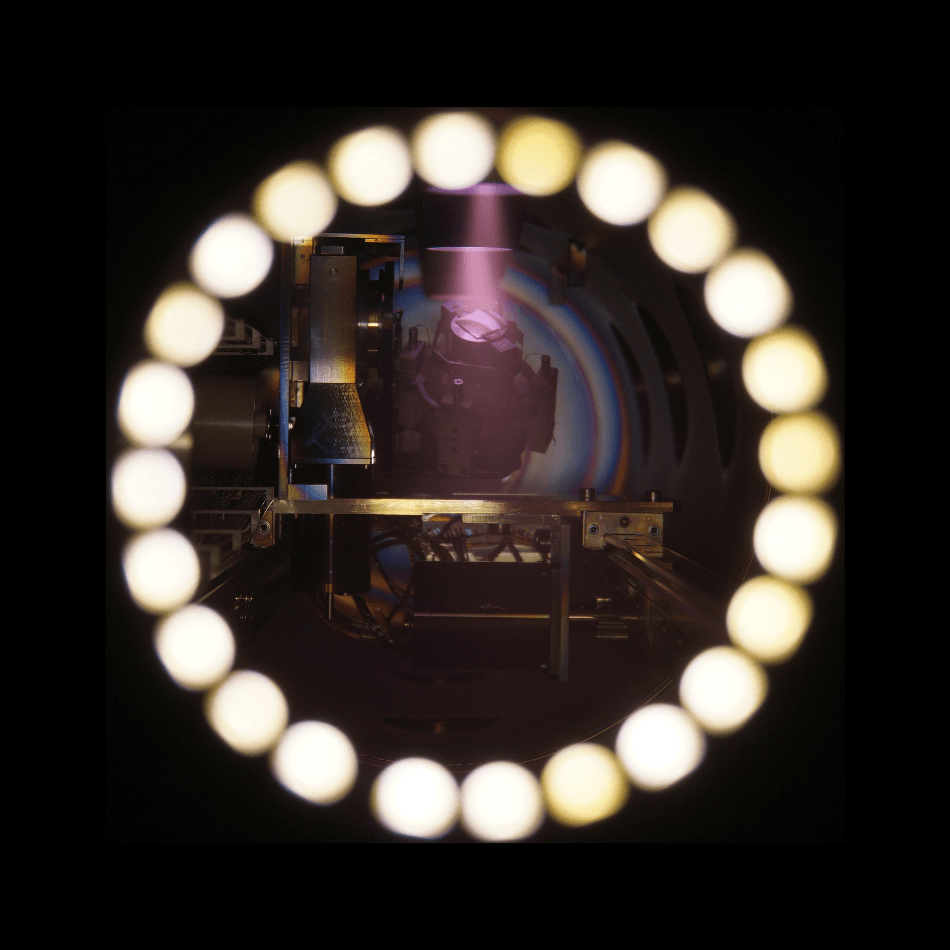Sep 15 2016
 A tailor-made vacuum deposition chamber (Andrey Siemens, Kai Schlage) is used to fabricate multilayer stacks with new sensor functionalities. One translation and two rotation motors position the wafer relative to the deposition sources and nanometer-thin film stacks are grown via subsequent deposition cycles. (Credit: Kai Schlage, DESY)
A tailor-made vacuum deposition chamber (Andrey Siemens, Kai Schlage) is used to fabricate multilayer stacks with new sensor functionalities. One translation and two rotation motors position the wafer relative to the deposition sources and nanometer-thin film stacks are grown via subsequent deposition cycles. (Credit: Kai Schlage, DESY)
DESY researchers have developed a technique that could lead to a new generation of magnetic sensors. Their method can be used to significantly widen the functionality of such sensors, which is narrow when traditional production techniques are used, so that current sensors can be independently customized to suit a number of new applications.
The researchers have published their manufacturing method in the scientific journal Advanced Functional Materials.
Magnetic sensors – or more specifically, magnetoresistive sensors – are miniature, extremely sensitive, and efficient components that can be found everywhere in daily life. For example in cars, they measure the speed of rotation of the wheels for ESP and ABS systems; they are found in mobile phones; they read data from hard drives and assist in safety by detecting minuscule cracks in metal parts.
The variety of the applications means that the functionality of the sensors needs to be independently tuned to each.
Magnetoresistive sensors are composed of microscopic stacks of alternating magnetic and non-magnetic layers, with each layer measuring a few nanometers in thickness. When an external magnetic field is applied to this sort of a multilayer stack, the electrical resistance of the stack alters.
This giant magneto-resistive effect (GMR) was first discovered by Albert Fert and Peter Grünberg for which they were awarded a Nobel Prize in 2007.
GMR has transformed sensor technology, but there was still an exisiting issue: the magnetic field strength at which the resistor swaps is mostly fixed. The team at DESY have now designed a procedure that allows them to manipulate the magnetoresistive properties of multilayer sensor systems.
Their technique allows the field strength where each individual magnetic layer in the miniature stack swaps to be flexibly and precisely modified. In addition, the favored direction for the magnetization of the individual layers - the “easy axis” - can be in any preferred orientation. Consequently, numerous new sensor properties can be realized in an easy manner.
Until now, it has often been necessary to adjust the application to fit the sensor; our technology means that we can customise the sensor to fit the intended application.
Dr. Kai Schlage, DESY
The enhanced sensor technology is based on a process called oblique incidence deposition (OID). The technique, which is already in use for single layers, enables arbitrary magnetic materials to be magnetically shaped on arbitrary substrates.
The angle of deposition can be precisely mixed and offers a simple way to establish if a magnetic layer swaps when the external magnetic field accomplishes strength of 0.5 milliteslas or 100 times that level. This corresponds roughly to the difference between 10 and 1000 times the strength of the magnetic field of the Earth.
DESY’s researchers found that this technique can not only be used for single layers, but is also suitable for numerous multilayer systems, greatly expanding the possibilities available in traditional design as well as the operations of magnetic multilayer stacks.
The team produced their multilayer systems in vacuum machines specifically designed for this reason. They then performed experiments on the P01 beamline of DESY’s synchrotron radiation source PETRA III to precisely measure the magnetic properties of each layer of the stacks generated and were thus able to show that OID allows arbitrarily complex and, most significantly, new magnetization structures to be developed in widespread multilayer stacks with very high precision.
In terms of magnetic sensors, this means that it is currently possible to manufacture microstructured multilayer stacks possessing identical compositions of materials and thicknesses but displaying very different and novel sensor attributes.
Our procedure allows to produce magnetic sensors that deliver significantly more precise signals containing more information that are also easier to process. This allows for instance to monitor rotational movements much more precisely than possible today, significantly improving the safety of motors, drive units and engine control systems, especially under extreme conditions.
Professor Ralf Röhlsberger, DESY
The team has filed a patent application for its technique and hopes to exhibit its commercial potential in a joint venture with industrial partners.